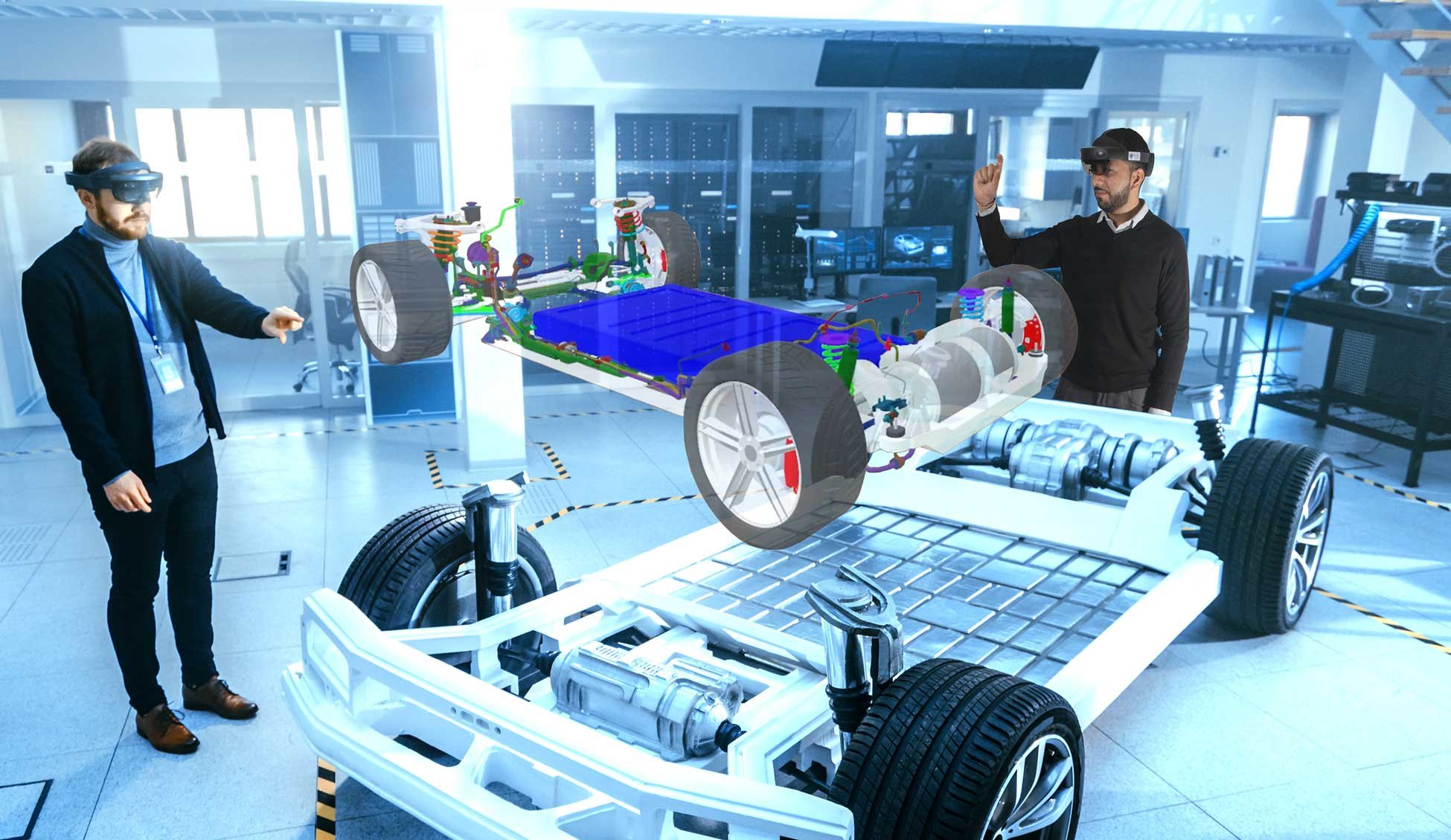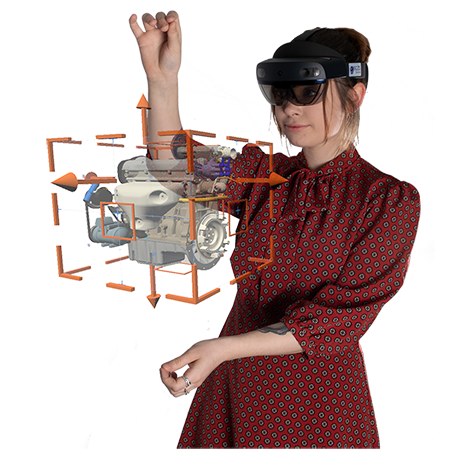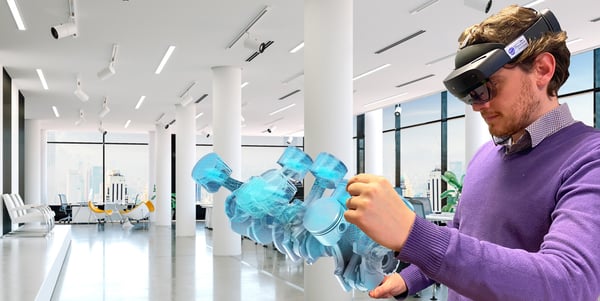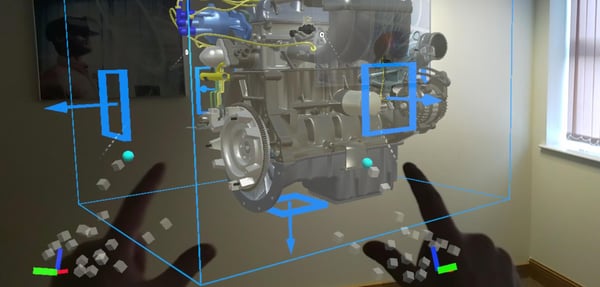
Getting Started with HoloLens Mixed Reality
In Engineering and Manufacturing
- Starting the Mixed Reality Conversation
- Understanding the Impact of HoloLens on the Use case
- Choosing a Solution
- Who Should own Mixed Reality within an Organisation?
- What do you need to Consider?
- What are the biggest Challenges?
- The Time is Now!
- Theorem Solutions and the Microsoft HoloLens
- Lets Talk! Get in Contact
Starting the Mixed Reality (MR) conversation
Integrating Microsoft HoloLens into engineering and manufacturing workflows takes time and involves investment, but in the long run it will save manufacturers money and cut lead times by improving processes.
Businesses are now moving away from focusing on the technology and devices they want to use, to a phase of planning how best to deploy, and achieve a financial return from, investments in MR.
But where to start? Lots of people talk in grandiose terms about having a MR strategy, but you can’t really have one unless you understand something about the technology and where it’s going to help and benefit your business.
Understanding the impact of HoloLens on the Use Case
You have to recognise that you are going to have to go through an educational learning process first and that you’ve got to invest in that in order to have some understanding of how using HoloLens might impact your business. Then you can look at what you’ve learnt, and from that decide what use cases it will give the most benefit to. And then you’ll need support from innovation / IT areas to deliver that to the business.
Taking a full ‘we’ve got to have a strategy’ approach is very premature at this stage. Have a plan - a plan where you can identify the use case. Deliver that for the business, show benefit, and also show how it will affect the business in the broader sense and affect your existing workflows and processes.

At that point, you can look at a strategy for the whole business and involve other groups who will affected. But, don’t think you can create a strategy now without a greater understanding, without seeing how it will improve the business and without understanding how it will affect other workflows. Create a plan, deliver the plan, and then you can look at a wider strategy picture.
Choosing a Solution
You’ve got HoloLens and the use case but the other thing to think about to think about is the actual solution, the application you are going to use. This is another key decision that needs to be made fairly early on.
Theorem, along with other solution providers, offer off the shelf, out the box technologies. When looking for your ‘out the box’ solution, do some research on who the providers are in relation to your use case. Speak with them, try out their technology. You’ll need to make some early investment in hardware to do that, but that’s relatively low cost.
It's also important to factor in how you are planning on getting your data in to HoloLens. You don’t want to have to manually rework it to make it usable in HoloLens, ideally you just want to be able to simply drag and drop it on to HoloLens, Save as from CAD, or drive it from PLM.
That will obviously then guide how much effort, time and support you need from IT and/or internal development groups to do that.
Who should own Mixed Reality within an organisation?
Because using HoloLens within a business is relatively new, you often find that individual groups or individual departments across engineering and manufacturing, as well as sales and marketing, might be driving their own initiatives.
You don’t want to stop individual departments necessarily from researching available technologies as ‘THE’ solution, because they understand their use cases better than anybody. That said, those departments will need help and support, so IT or innovation groups will also need to be involved and need to support the end users in terms of how it might fit into the IT strategy, how it might be deployed etc.
Most big organisations will probably have a Chief Technical Officer or Innovation Manager/Director etc., who will also be looking at new technologies to see how they can help and improve the business.
To add value, HoloLens needs to solve real business problems. It’s a good idea, especially for those that have many different business units, to create some sort of shared group, where you can share experiences. But also probably more importantly, share those use cases and potential solutions, because you’re bringing even more economies of scale into the organisation.

It’s key that it has to be use case driven, which really means it has to be led by end user departments. Without a strong use case, you’re unlikely to get traction, and so the first thing people should focus on is to decide what area of the business they think using HoloLens might help them, whether it’s design, manufacturing, inspection, training or remote assistance.
Ultimately, unless it’s driven by end users, it won’t get traction in the business.
Considerations
Consider how using HoloLens technology is going to improve an existing process? Will it save time? Will it reduce build cost? The manufacturing assembly time? Will it improve your service process? Will it improve your time to market? Think about the business benefits and the return on investment. Without that, it’s unlikely to get management to provide the manpower to go ahead, or to provide the budget to go forward. Without those things, whatever you choose to do will flounder.
There needs to be a ‘change management’ approach as well. So, not only is it technology deployment, but it’s hearts and minds and working with the whole organisation.
What are the biggest challenges companies need to overcome to successfully deploy enterprise MR?
There are a lot of challenges, but they are all manageable. One of the first things to recognise is, don’t believe what you see on YouTube, depicting the amazing things both the hardware and software can achieve. Be realistic about what you will be able to do.

Choose a use case, look at what is a good approach to solving it and run with it. Don’t try and boil the ocean. Break it down into small elements which will improve your business, and then go out and solve that, and prove that that effect can happen. If you try to be too broad in it, with all the factors to take into consideration, the chances are you won’t get there. Choose a practical use case, and choose elements of that which can be delivered today. You will then show benefit to the business.
Some people think, ‘well, should we therefore wait until it matures?’. If you do, what you’ll find is that your competitors will be 5 years ahead of you. Lots of large companies have already started down this journey and are doing things – understanding it and seeing how it will help and improve their business.
The Time is Now!
With the shift in 2020 towards remote working, the remote collaboration capabilities of HoloLens are more relevant than ever. Now is the time to start making some decisions around your engineering and manufacturing processes and the technology that you could be using.
Today, some organisations have made significant progress. They have adopted this technology and use it every day – they rely on it to perform at a higher level. It has kept them from having to slow down, or completely shut down, when others have. What started as an idea is now being used by teams globally; growth and adoption is still accelerating as more people are exposed to the benefits it brings.
Theorem and HoloLens
Theorem-XR provides solutions which enable companies in a fully automated process to use their rich 3D CAD data in Mixed Reality to address a number of different use cases. Our MR Experiences for HoloLens provide solutions for Design Review, Factory Layout, Training, Work Instructions, Visualization and the Visual Digital Twin.
The experiences work collaboratively, enabling remote teams and home based staff to work in an immersive environment.
As a Silver Partner of Microsoft’s Mixed Reality Partner Program, Theorem Solutions are committed to providing high value and high quality solutions to HoloLens users, enabling them to extend the value of their 3D CAD assets.
Learn more about how Valiant TMS are already benefiting from integrating Hololens into their existing daily engineering and manufacturing processes by reading our Valiant TMS case study.
Reach out to schedule time with the team
We're here to help
Talk to our XR team today. If you aren't sure where to start or which device would most suit your use case; perhaps you don't have a specific use case defined yet? We can help you to make sense of the market and what is available today with an unbiased and neutral opinion.
If you are at the next stage of your XR journey and have already chosen your use case and device, but are struggling to get existing data on to your HMD, we can demonstrate how a simple drag and drop solution can be implemented.
At whichever stage you are at in your XR journey, we are here to help.
